
The orange-headed thrush is a bird in the thrush family.

The tiger shrike or thick-billed shrike is a small passerine bird which belongs to the genus Lanius in the shrike family, Laniidae. It is found in wooded habitats across eastern Asia. It is a shy, often solitary bird which is less conspicuous than most other shrikes. Like other shrikes it is predatory, feeding on small animals. Its nest is built in a tree and three to six eggs are laid.

Prosopocoilus giraffa, the giraffe stag beetle, is the world's largest stag beetle and is a member of the family Lucanidae within the order Coleoptera. They have very long, toothed and notched mandibles that protrude about half the size of their body. They tend to be aggressive and are fierce and powerful. Males fight each other using these strong and enlarged jaws to lift and throw rivals to win a mate. They can grow up to 119 millimetres in length. Several distinctive populations (subspecies) are found in moist forested region areas of Asia, ranging from India to Indonesia. Prosopocoilus giraffa keisukei can measure up to 12 centimeters. Prosopocoilus giraffa daisukei have the brightest elytra of all subspecies and Prosopocoilus giraffa giraffa is the smallest subspecies.

The golden-headed cisticola, also known as the bright-capped cisticola, is a species of warbler in the family Cisticolidae, found in Australia and thirteen Asian countries. Growing to 9–11.5 cm (3.5–4.5 in) long, it is usually brown and cream in colour, but has a different appearance during the mating season, with a gold-coloured body and a much shorter tail. It is an omnivore and frequently makes a variety of vocalizations. Known as the "finest tailor of all birds", it constructs nests out of plants and spider threads. It mates in the rainy season. It has a very large range and population, which is thought to be increasing.

The Amboina box turtle or Southeast Asian box turtle is a species of Asian box turtle.
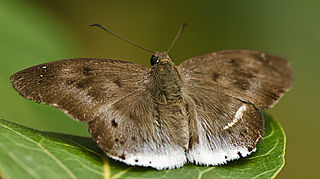
Tagiades japetus, commonly known as the pied flat or the common snow flat, is a species of spread-winged skipper butterfly belonging to the family Hesperiidae. It is widely distributed, being found from India, the Himalayas, Southeast Asia, to Australia. It contains several recognized subspecies.

Lamproptera meges, the green dragontail, is a species of swallowtail butterfly found in parts of South Asia and Southeast Asia. There are ten subspecies. A specimen from Java is the type species of the genus Lamproptera.

Kaloula baleata, the flower pot toad or sometimes the smooth-fingered narrow-mouthed frog, is a species of narrow-mouthed toad. It is native to India, Borneo, Indochinese Peninsula, Java, Malay Peninsula and Philippines where it lives in lowland rainforests and is tolerant of disturbed sites. The IUCN lists it as being of "Least Concern".

Nacaduba pavana, the small four-line blue or Singapore four-line blue, is a species of lycaenid butterfly found in Southeast Asia.

Hypolycaena erylus, the common tit, is a small but striking butterfly found in India and South-East Asia that belongs to the lycaenids or blues family. The species was first described by Jean-Baptiste Godart in 1823.
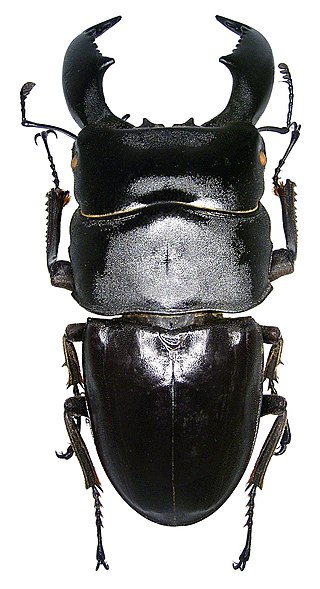
Dorcus titanus is a beetle of the family Lucanidae. It was described by Jean Baptiste Boisduval in 1835. Huang and Chen (2013) separated Serognathus from Dorcus by representing morphological characters and DNA analysis.

Odontolabis cuvera, the golden stag beetle, is a beetle of the family Lucanidae, stag beetles.
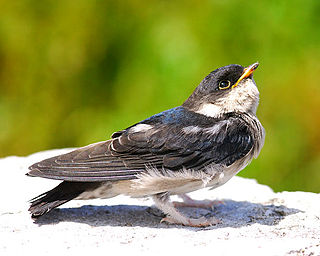
The Asian house martin is a migratory passerine bird of the swallow family Hirundinidae. It has mainly blue-black upperparts, other than its white rump, and has pale grey underparts. Its three subspecies breed in the Himalayas and in central and eastern Asia, and spend the winter lower in the mountains or in Southeast Asia. This species is locally abundant and is expanding northward in Siberia, so there are no concerns about its conservation status.

The lesser coucal is a species of cuckoo in the family Cuculidae. It has a wide distribution range that overlaps with several other similar species. The habitat in which it is found is often marshy land with grass and tree cover. It is distinguished by its smaller size, less prominent bill, pale shaft streaks on the feathers of the head and back. It has a much longer claw on its hind toe and a distinct call. It is also among the few coucals that show season plumage differences but like in other coucals, the sexes cannot be distinguished in the field.
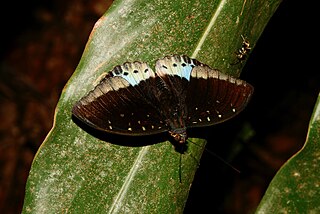
Lexias pardalis, the common archduke, is a butterfly of the family Nymphalidae.

Hexarthrius parryi, the fighting giant stag beetle, is a species of large stag beetles. It belongs to the genus Hexarthrius of the tribe Lucanini. It is classified under the subfamily Lucaninae of the stag beetle family Lucanidae.

Odontolabis is a genus of beetles belonging to the family Lucanidae.

Dorcus taurus is a species of beetle belonging to the family Lucanidae which was described by Johan Christian Fabricius in 1801.
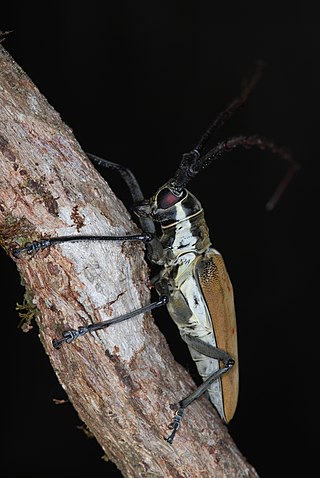
Batocera numitor, the mango-tree longicorn borer, is a species of beetle in the family Cerambycidae. It was described by Newman in 1842. It is known from China, Java, India, Laos, Nepal, Myanmar, the Philippines, Sulawesi, Sri Lanka, Thailand, Sumatra, and Vietnam. It feeds on plants including Mangifera indica and Quercus griffithii.
Hexarthrius melchioritis is a species of beetle, which belongs to the family of stag beetles (Lucanidae) in the group Scarabaeoidea.



















